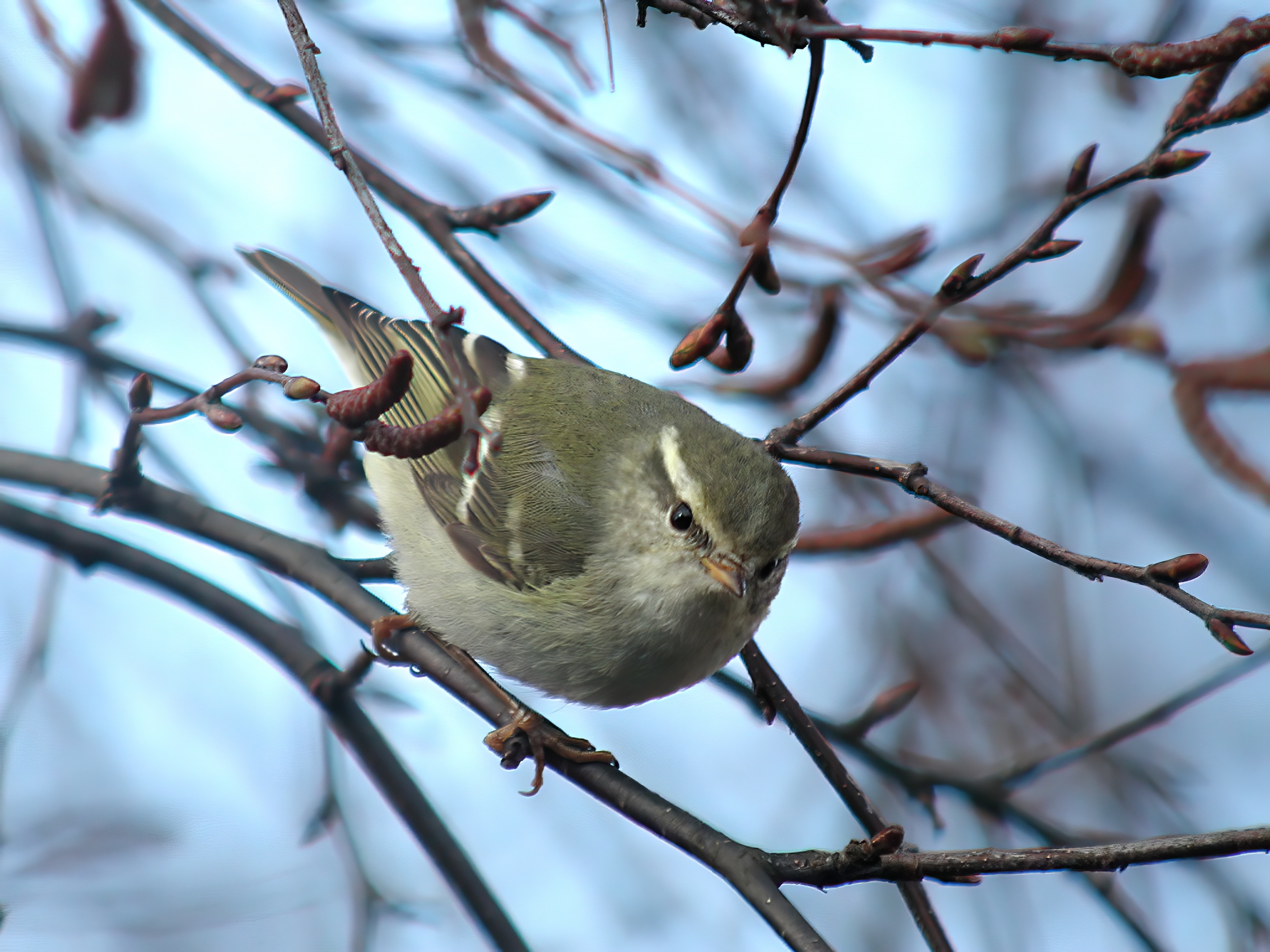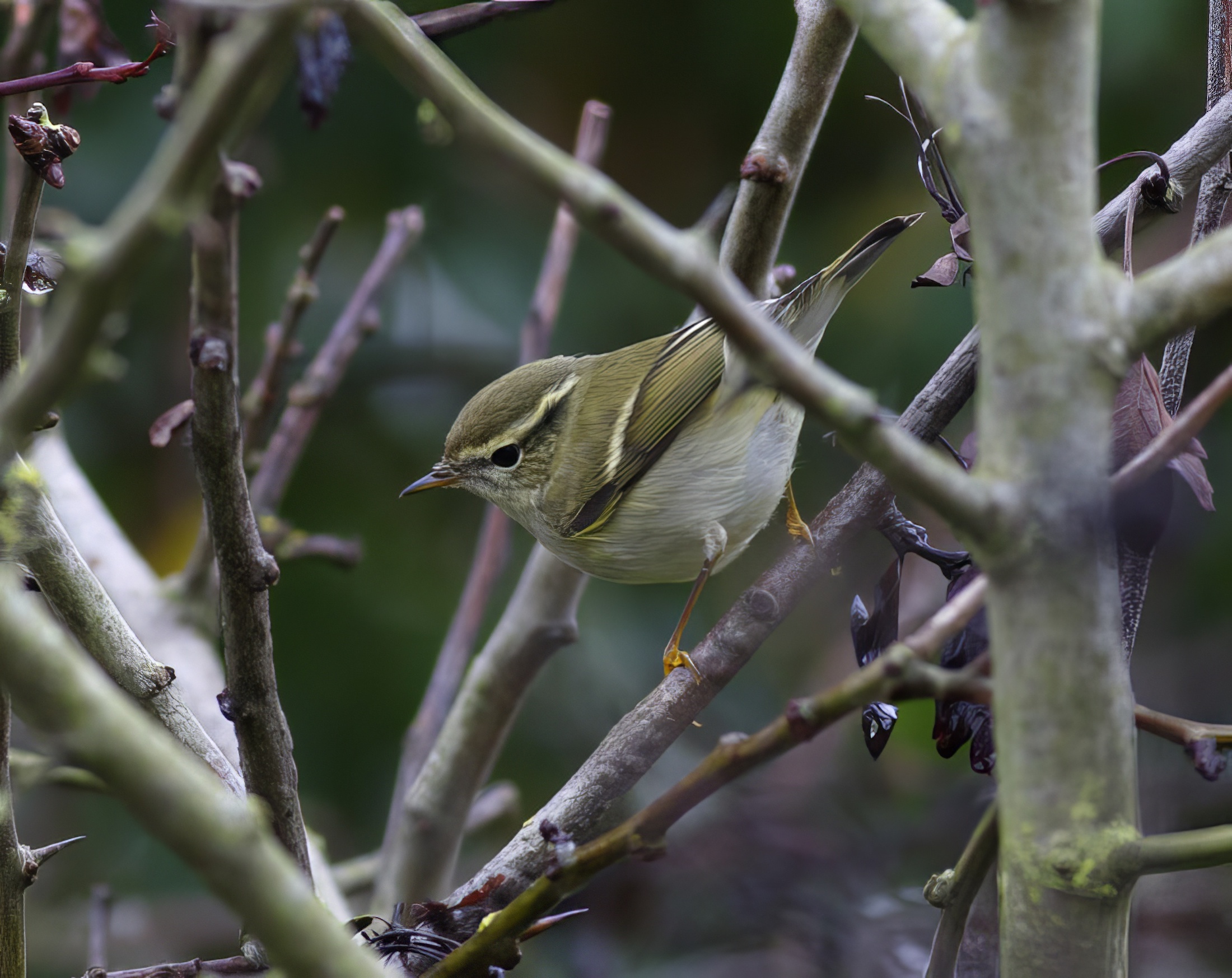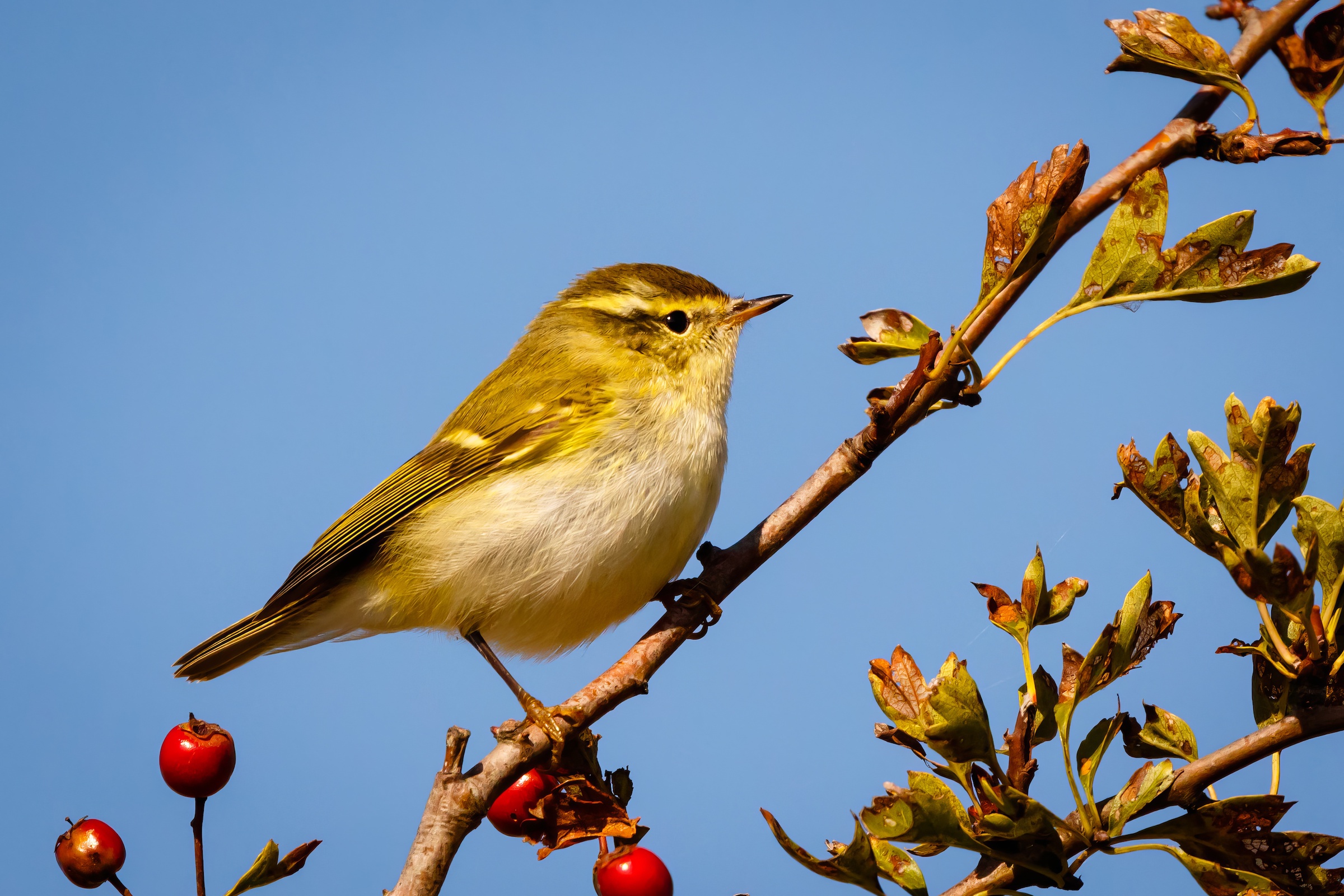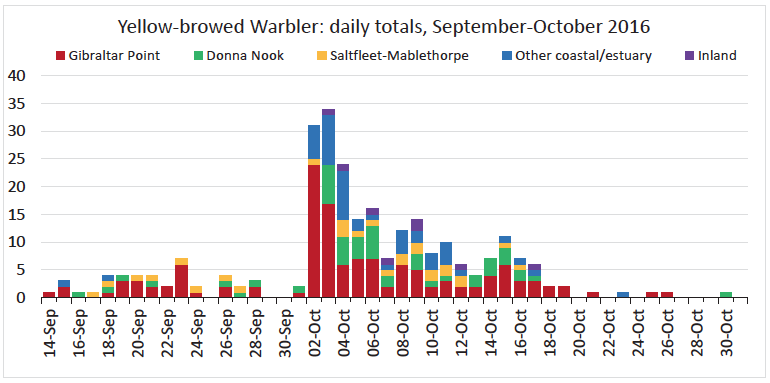Yellow-browed Warbler Phylloscopus inornatus
Scarce but increasing passage migrant Sep-Nov, very scarce inland.



Yellow-browed Warblers: left, Louth March 4th 2004 (Graham Catley); centre, Lincolnshire coast October 6th 2015 (Graham Catley); right, Donna Nook October 4th 2016 (John Clarkson).
Yellow-browed Warbler - the early records
The first county record was of one shot on 7th October 1892 near North Cotes by G. H. Caton Haigh who recorded the following note in The Zoologist v.16 (1892):
“On October 7th I shot a specimen of the Yellow-browed Warbler, Phylloscopus superciliosus, from a hedge near the sea-bank at North Cotes. It flew out of the hedge as I was walking along the bank, and I saw at once, from its quick and even flight and brighter colour, that it was not a Goldcrest. There was a fresh west breeze blowing at the time, and no sign of migration among the smaller birds, which were singularly scarce in the sea-side hedges. Probably this bird had crossed on the previous day, when the wind blew lightly from the east, bringing with it the first Snow Bunting”. Caton Haigh obtained 13 birds in all at North Cotes between 1892 and 1932. The LNU Transactions (1912-1915) recorded the first five of these, all shot or found dead at North Cotes between the years 1892-1912, all in the autumn. Of the bird recorded in 1908, the second county record, Caton Haigh notes that “...there was a great migration of birds progress at the time”. This included thousands of Song Thrushes, hundreds of Robins and Goldcrests, and lesser numbers of Redwings, Blackbirds, Ring Ouzels, Grey Crows, Chaffinches, Greenfinches and Twites, with a few Brambling, Wheatears, Rock Pipits, Woodcocks, Merlins and Black Redstarts. A further eight birds were recorded in the county up to 1932, and all from North Cotes, remarkably within a mile or so of the same spot, as follows: September 18th, 1915; October 1st, 1919; September 23rd, 1921; September 28th, 1922; October 12th, 1923; October 19th, 1923; October 15th, 1930; October 12th, 1932. The final county record prior to the formation of a national Rarities Committee was of one seen (not shot!) at Gibraltar Point, October 7th, 1949. As these records are all well documented as the first tranche to have occurred in the county they are tabulated below:
| Date | Site | Notes |
| 07/10/1892 | North Cotes | Shot |
| 19/10/1908 | North Cotes | Found dead |
| 12/10/1909 | North Cotes | Male, shot |
| 03/10/1910 | North Cotes | Male, shot |
| 25/09/1912 | North Cotes | Shot |
| 18/09/1915 | North Cotes | - |
| 01/10/1919 | North Cotes | Shot |
| 23/09/1921 | North Cotes | Shot |
| 28/09/1922 | North Cotes | Shot |
| 12/10/1923 | North Cotes | Shot |
| 19/10/1923 | North Cotes | Shot |
| 15/10/1930 | North Cotes | Shot |
| 12/10/1932 | North Cotes | Shot |
| 07/10/1949 | Gibraltar Point NNR | Seen in the field |
Catley (1985) published a review of Yellow-browed Warblers in Lincolnshire, 1960-1985, noting at the time that the 21 records in 1985 was unprecedented for the county, and by the time The Birds of Lincolnshire and South Humberside was published in 1989, there had been more than 125 records and Yellow-browed Warbler was recognised as one of the most regular and numerous Siberian vagrants to visit Western Europe.
Since 2010, this small “Phyllosc” has become almost too frequent to accurately record their annual arrival pattern in autumn. Always treated as a scarce migrant in Britain, White and Kehoe (2019) in the Report on scarce migrants in Britain in 2017: part 2, passerines announced hence forth they would no longer be considering the species. In 2017 there were nearly 2000 British records, half the total being in the 2016 record arrival (chart). Writers in LBR shared their pain and gave up after 2016 that saw a suspected 148 individuals in Lincolnshire. This followed what had seemed big years in 2014 (45) and 2015 (94).
This species has been expanding its range west of the Urals and increasing numbers appear to be wintering in south-western Europe. Formerly the species migrated south-east to winter in South East Asia. Their autumn arrival in Britain corresponds with easterly airflows and the phenomenon of reverse migration was invoked to explain their occurrence. It now appears we have been watching evolution in action over the last 50 years as the population has switched migration strategy by optimising their chances of winter survival by shorter migration routes. To emphasise this point, a bird ringed at Gibraltar Point on October 3rd, 2015 was retrapped at Nanjizal, Cornwall 7 days later. Did it end up in Iberia or the Atlantic Ocean? There is a good chance it was the former, but birders have always been concerned that the latter is more likely! In terms of big counts Gibraltar Point has seen most of the action with 24 on October 2nd and 16 on October 10th, 2018; also, there were 10 on October 3rd, 2015. The first spring records occurred in 2004 when was in Louth March 4th-10th followed by one at Gibraltar Point April 20th; another one was found May 7th, 2017. These are presumably surviving birds over-wintering and moving back north.
2016 - an "invasion" year
Examining the one of the recent “invasion year” in 2016, revealed that around 148 were recorded (accepting the difficulty of excluding duplicate records) which included 70 at Gibraltar Point, 30 at Donna Nook, 12 between Saltfleet and Mablethorpe, 30 in other coastal and estuarine areas, and six inland. Thus the record total of 94 in 2015 was promptly exceeded by around 50% in 2016. The first one was at Gibraltar Point on September 14th, and small numbers continued to be seen until the 28th but the big arrival came on October 2nd with 24 at Gibraltar Point alone. Moderately high numbers were maintained for another ten days or so, including up to seven at Gibraltar Point and up to six at Donna Nook, and there were no fewer than eight in Cleethorpes on October 8th. That last count, by an observer searching an otherwise poorly covered area, hints at the number that must have been missed away from the hot spots. There was also a scattering of inland records showing that birds were spread across the county. The chart below shows daily totals (including birds remaining from previous days) up to the end of October. There was one later record at Gibraltar Point on November 23rd not included on the chart.

References
Baker, J. K., & Catley, G. P. (1987). Yellow-browed Warblers in Britain and Ireland, 1968–85. British Birds 80: 93–109.
Catley, G. P. (1985). The Yellow-browed Warbler in Lincolnshire. Lincolnshire Bird Report 1985: 14-16.
Caton Haigh, G.H. (1910). Yellow-browed Warbler in Lincolnshire. British Birds 4(7), 209.
Fraser, P.A., and Rogers, M.J.(2006). Report on scarce migrants in Britain in 2003. Part 2: Short-toed Lark to Little Bunting. British Birds 99(3), 129-147.
White, S. and Kehoe, C.(2014). Report on scarce migrant birds in Britain in 2008-10. Part 2: passerines. British Birds107(5), 251-281.
(Account as per new Birds of Lincolnshire (2021), included October 2022)
